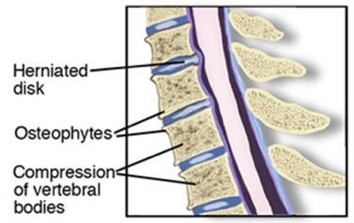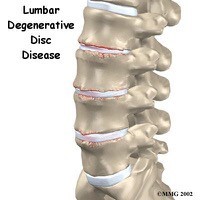Usually the result of the natural aging process, degenerative disk disease (DDD) is a type of osteoarthritis of the spine. As we age, and sometimes with injury or excessive wear and tear, we start to lose some of the gelatin of the intervertebral discs that protect our spine. The volume of the disk decreases, resulting in less space between the vertebrae. The disk becomes flatter and less flexible, leaving less space between each set of vertebrae. Sometimes bone spurs form in response to this degeneration of the disk, making the spine stiff. When the rough surfaces of the vertebral joints rub together, pain and inflammation may result. Nerves may become irritated or compressed. Disk degeneration might occur throughout several regions of the spine, or it might be limited to one disk. Pain varies from mild to severe depending on location and cause of disc degeneration. When it is a result of the natural aging process, the degeneration does not always lead to pain. For some people, however, it can cause a great deal of pain and disability. A degenerative disk in the neck can cause pain in the arm, shoulder, or neck. A degenerative disk in the low back might cause pain in the back, buttocks, or legs. The pain is often made worse by sitting, bending, and reaching. It may be worse first thing in the morning and after staying in any one position for a long time. In severe cases, when DDD results in pressure on the nerves, it can lead to numbness, tingling, and even weakness in the arms or legs.

